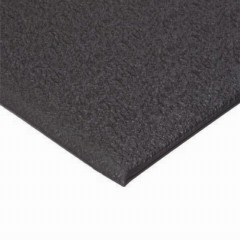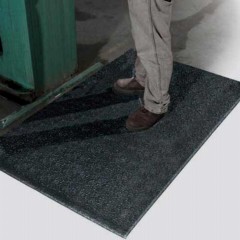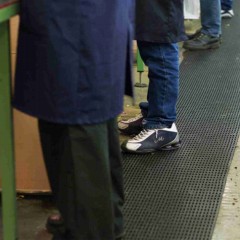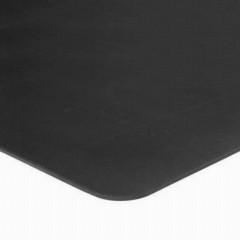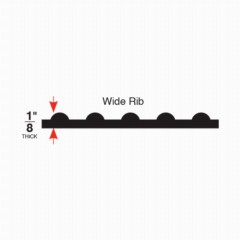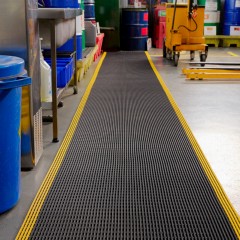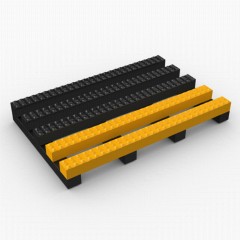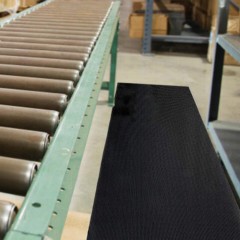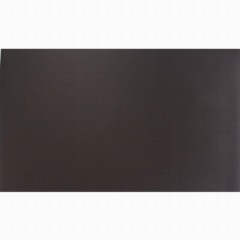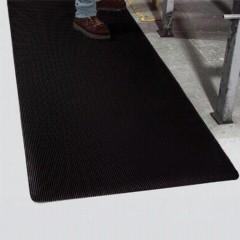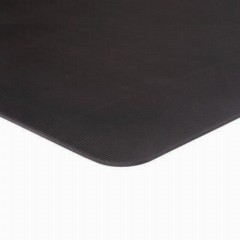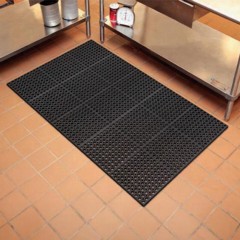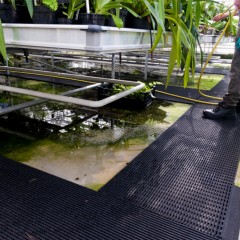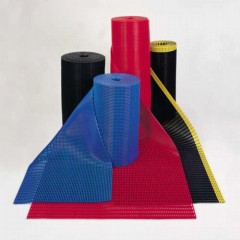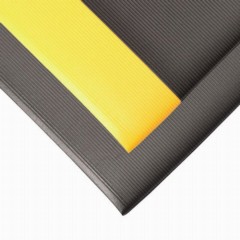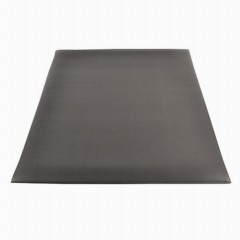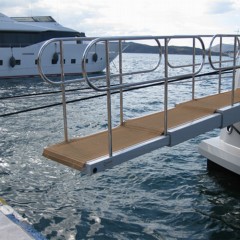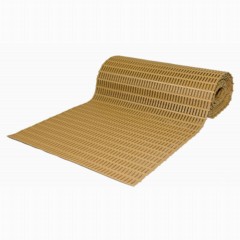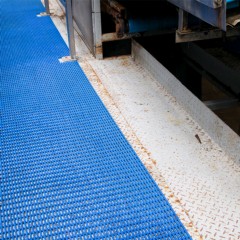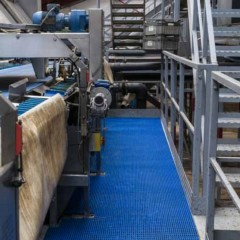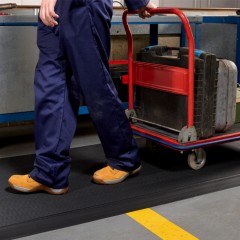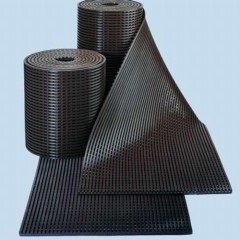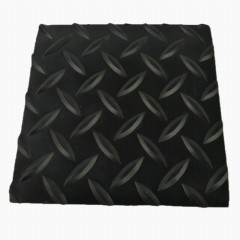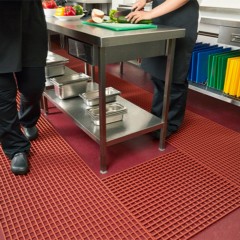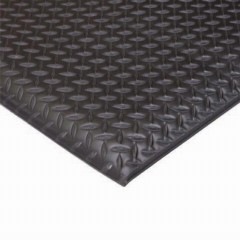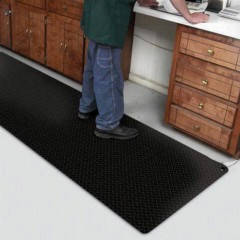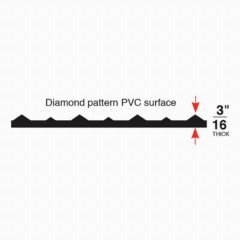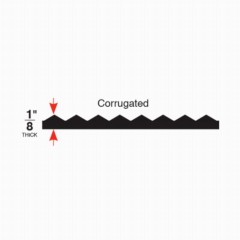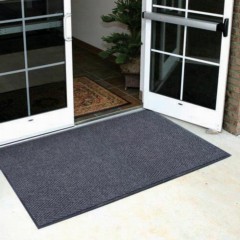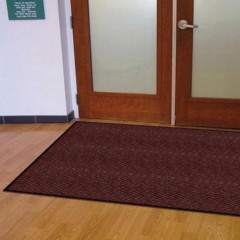Options for Industrial Floor Runners
Industrial floor runners are extremely durable floor mats that you can use at a manufacturing site, factory, or industrial center. Commercial-grade runners for floors can deliver anti-fatigue and anti-slip capabilities that are perfect for people who work in harsh environments.
At Greatmats, we have a wide range of heavy-duty floor runners that our customer service team can match to your facility’s needs. When the work is exceptionally tough, our industrial runner mats can be just as tough while still providing a far more comfortable surface than bare concrete.
Types of Industrial Runners
At Greatmats, we offer two forms of industrial runners.
Rolls
When you buy commercial carpet runners by the roll (or another material like PVC plastic, foam, vinyl, or rubber), you can cover a large space in a short amount of time. If you need to cover a long, narrow space, such as along an assembly line, a roll is the best choice.
Floor Mats
Floor mats that work as industrial runners can be quite long and narrow, too, but they usually consist of thicker materials, meaning they won’t roll up for storage. While rolls could be up to 100 feet long, a mat is usually no more than 60 feet long.
Materials and Sizes of Industrial Floor Runners
We offer several different materials in our non-slip industrial anti-fatigue runner products.
PVC Plastic
PVC plastic is a popular material available for a runner to go over existing flooring. It has a nice mixture of firmness for stability with a slight cushioning to keep employees who are standing on the runner feeling comfortable throughout the workday. Another advantage of PVC plastic is that it does not soak up liquids.
Vinyl
Vinyl is a popular material for floor runners, as it has quite a bit of durability and versatility. Manufacturers can make vinyl runners in extremely thin configurations, which is better for reducing the tripping hazard compared to the lip of a thick runner mat. When using clear vinyl in a runner, it allows the flooring underneath to be visible while also protecting it.
Foam
A foam runner will provide the highest level of cushioning in runners. The foam delivers a nice firmness that supports people standing on it, too, although it isn’t as durable or firm as PVC plastic or other materials. It lasts a long time in the right usage situations, providing good value.
PVC/Foam
Some manufacturers mix foam with PVC plastic to create a little more durability and firmness than foam alone. This combination should give the runner many of the benefits of both materials.
Carpet
Industrial carpet runners often appear at the entrance to a building, giving people walking into the building the ability to scrape moisture and solids off their shoes. Using a carpet runner mat at the entrance keeps the flooring throughout the building cleaner and helps reduce a slip hazard on a wet floor near the entry door. You can purchase commercial carpet runners by the foot, ensuring you can match the size to the planned use case.
Rubber
A rubber runner mat is a smart choice for use in a kitchen or another area where spills are common. A solid rubber mat gives people a surface that will maintain traction, even when the rubber is wet from spills. Many rubber mats contain perforations that allow moisture to drain through to the subfloor, meaning workers do not have to stand in puddles from spills.
Benefits of Industrial Floor Runners
Some of the key benefits of selecting industrial floor runners include:
- Anti-fatigue properties
- Anti-slip properties
- Cushioning for lower body joints
- Perforations for draining standing water
- Coverage over a long, narrow space
- Variable lengths and widths of runners available
- Multiple materials available
- They protect the subfloor
- Easy to clean and maintain
- Yellow safety marks on the edges warn of trip hazards when stepping on and off a mat
- Indoor or outdoor usage
- Several colors available
Use Types for Commercial Floor Runners
You can place commercial floor runners in a variety of locations, including:
- Bars
- Restaurants
- Cafeterias
- Delis
- Commercial kitchens
- Food processing areas
- Assembly lines
- Warehouses
- Maintenance areas
- Factory lines
- Manufacturing facilities
- Industrial areas
- Repair garages
- Machine shops
- Areas with standing water
Industrial Floor Runners Q&A
When should you use a vinyl floor runner?
You should
use a vinyl floor runner when you need to prevent slips, create a safer walking space, protect carpeting at a workstation, guard against static electricity generation in a utility or computing space, and protect a gymnasium floor.
What size is a commercial kitchen floor runner?
The typical
size for a commercial kitchen floor runner is 2 to 4 feet in width and 5 to 100 feet in length. Select the coverage size that matches the type of work you plan to do. If you don’t move much around a preparation or dishwashing area, a small runner will work well. If you must move back and forth along an assembly line or preparation space, a longer runner is ideal.
What types of anti-fatigue mats are used for industrial use?
The
best types of anti-fatigue mats for industrial use will provide ergonomic benefits for people who must stand and work while providing protection to the subfloor from spills of chemicals, oils, solvents, liquids, and powdery substances. They need to use materials that fit the industrial use case you have in mind.
Why should you cover warehouse floors with industrial runners?
Covering warehouse floors with industrial runners is a good idea to create a safer area for workers and visitors. Bare concrete can be slippery when wet. Hard concrete floors are tough on lower body joints, while runners can improve the comfort level for workers, allowing them to work longer without suffering pain and fatigue. Runners can protect concrete flooring in a warehouse from oil, grease, and solvent leaks.
 $1,60594 /Mat You Save 3%$6.69/sqftShop$1,36553 /Roll You Save 14%$13.79/sqftShop$1,28627 /Roll You Save 15%$19.49/sqftShop$32080 /Mat You Save 20%$2.14/sqftShips Out in 11-14 Working Days SustainableShop$40750 /Mat You Save 19%$2.72/sqftShips Out in 11-14 Working Days SustainableShop$99742 /Roll You Save 14%$15.11/sqftShop$36345 /Mat You Save 19%$3.03/sqftShips Out in 11-14 Working DaysShop$2,04439 /Mat You Save 20%$9.09/sqftShips Out in 11-14 Working DaysShop$24762 /Mat You Save 19%$1.18/sqftShips Out in 11-14 Working DaysShop$54517 /Mat You Save 19%$3.03/sqftShips Out in 11-14 Working DaysShop$72690 /Mat You Save 19%$3.03/sqftShips Out in 11-14 Working DaysShop$80296 /Mat You Save 2%$6.69/sqftShop$26765 /Mat You Save 3%$7.43/sqftShop$1,20445 /Mat You Save 2%$6.69/sqftShop$49523 /Mat You Save 20%$2.75/sqftShips Out in 11-14 Working DaysShop
$1,60594 /Mat You Save 3%$6.69/sqftShop$1,36553 /Roll You Save 14%$13.79/sqftShop$1,28627 /Roll You Save 15%$19.49/sqftShop$32080 /Mat You Save 20%$2.14/sqftShips Out in 11-14 Working Days SustainableShop$40750 /Mat You Save 19%$2.72/sqftShips Out in 11-14 Working Days SustainableShop$99742 /Roll You Save 14%$15.11/sqftShop$36345 /Mat You Save 19%$3.03/sqftShips Out in 11-14 Working DaysShop$2,04439 /Mat You Save 20%$9.09/sqftShips Out in 11-14 Working DaysShop$24762 /Mat You Save 19%$1.18/sqftShips Out in 11-14 Working DaysShop$54517 /Mat You Save 19%$3.03/sqftShips Out in 11-14 Working DaysShop$72690 /Mat You Save 19%$3.03/sqftShips Out in 11-14 Working DaysShop$80296 /Mat You Save 2%$6.69/sqftShop$26765 /Mat You Save 3%$7.43/sqftShop$1,20445 /Mat You Save 2%$6.69/sqftShop$49523 /Mat You Save 20%$2.75/sqftShips Out in 11-14 Working DaysShop